POPULATION AND ASSOCIATED ISSUES
Population refers to the total number of people living in a specific geographical area at a given time. It is a critical factor in understanding the dynamics of human society and its interaction with resources, environment and development.
Rapid population growth, driven by advances in technology and healthcare, brings challenges like overpopulation, resource depletion and urban overcrowding, while regions with declining birth rates face labour shortages and economic stagnation.
| KEY FACTS |
|
Addressing these societal challenges requires collaborative efforts to promote education and healthcare, gender equity and sustainable resource distribution. Understanding and managing these dynamics is essential for building a more equitable and resilient society.
Why do we study Population?
- Why do we study Population?
- Importance of Studying Population
- Key Concepts in Population Studies
- DEMOGRAPHIC ANALYSIS
- Population growth
- Key determinants of Natural rate of growth
- Declining Birth Rate
- 2. Role of death rate
- Population growth theories
- Malthusian Theory of Population
- Demographic Transition Theory (DTT)
- Population Pyramid
- Types of Population Pyramids
- Analysis of Population Pyramid
- Related FAQs of POPULATION AND ASSOCIATED ISSUES
We study population to understand the dynamics of human societies and their impact on resources, economy and the environment. The study of population is central to demography, economics, sociology and public policy.
Importance of Studying Population
- Economic Development: Population size and growth influence the labour market, productivity and economic output.
- Resource Management: Understanding population trends helps in managing natural resources sustainably.
- Social Infrastructure: Effective planning of education, healthcare and housing requires knowledge of population characteristics.
- Environmental Impact: Population growth affects biodiversity, pollution levels and climate change.
- Policy Formulation: Demographic data aids in formulating welfare policies like employment schemes, food security and urban planning.
Key Concepts in Population Studies
- Population Growth: The increase in the number of individuals in a population over a specific period.
- Population Density: The number of people per unit area, indicating spatial distribution.
- Population Composition: The structure of a population based on age, sex, education and occupation.
- Demographic Transition: The shift from high birth and death rates to low rates as a country develops.
- Fertility, Mortality and Migration: Key factors influencing population changes.
This chapter explores the intricate relationship between population and society, providing valuable insights for addressing these challenges and paving the way toward a sustainable future.
DEMOGRAPHIC ANALYSIS
Demographic analysis is the scientific study of the characteristics of human populations, such as size, growth, density, distribution and composition. It provides essential insights into population dynamics and their impact on social, economic and environmental aspects.
Demographic analysis and population growth are closely interconnected, as demographic analysis provides the tools and data to understand, measure and interpret population growth patterns and their implications.
Population growth
Population growth refers to the increase in the number of people in a specific region over a certain period of time. It is driven by birth rates, death rates and migration, as per the relation given below:
| Types of Population Growth |
|
Natural rate of growth
The natural rate of growth refers to the rate of increase or decrease in the population of a specific area due to the balance between birth rates and death rates, excluding the effects of migration. It is a key concept in demographic studies, as it highlights the internal factors driving population change.
We will study more about the role of migration in the later section.
Key determinants of Natural rate of growth
The natural rate of population growth is determined by the difference between the birth rate and the death rate. It reflects population changes excluding migration, shaping labour supply and economic potential.
1. Role of birth rate
Birth rate, defined as the number of live births per 1000 people in a given population annually, is a key demographic indicator that profoundly impacts societal development.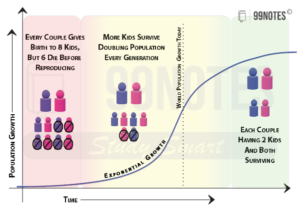
- High birth rates contribute to rapid population growth, especially in regions with low death rates and improved healthcare.
- Conversely, low birth rates can lead to slowed growth, stagnation or even population decline. The balance between birth and death rates largely determines whether a population expands, stabilizes or shrinks over time.
Declining Birth Rate
- Throughout history, global birth rates have fluctuated significantly, reaching historic highs during periods of economic prosperity, post-war recovery, and agricultural expansion.

- The post-World War II “Baby Boom” saw birth rates surge due to economic stability and optimism, while earlier agrarian societies had high birth rates for labour needs.
- Over recent decades, improved healthcare, lower infant mortality, contraception access, and changing social norms have driven a decline in fertility. Today, record-low birth rates pose significant challenges for ageing populations and societal sustainability.
- This contrast between past highs and the current decline illustrates the evolving dynamics of human reproduction influenced by technological, economic, and cultural transformations.
This trend has been explained through the Demographic Transition theory above, where industrialization and modernization reduce both birth and death rates over time.
2. Role of death rate
The death rate is defined as the number of deaths in a given population over a specific period, usually expressed per 1,000 people per year. The death rate plays a crucial role in population growth because it directly impacts the overall rate of population increase or decrease.
It influences population growth in the following ways:
- Decreasing Death Rate: When the death rate decreases, typically due to advances in healthcare, better nutrition, sanitation, and medical treatment, the population tends to grow more rapidly. A lower death rate means more individuals survive to reproduce, thus contributing to a higher growth rate.
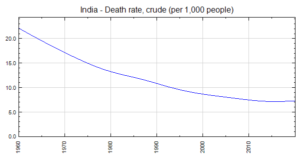
- Increasing Death Rate: Conversely, an increase in the death rate due to factors like disease, malnutrition, natural disasters or poor healthcare can slow down population growth. If deaths outpace births, the population may stabilize or even decline.
- Balance with Birth Rate: Population growth is determined by the balance between birth rate and death rate. When the birth rate exceeds the death rate, the population grows. When the death rate exceeds the birth rate, the population declines. A stable population is maintained when these rates are approximately equal.
Overall, changes in the death rate can have a significant impact on the rate of population growth. The interplay between birth and death rates ultimately determines whether a population increases, declines or remains stable.
Population growth theories
Population growth is a central concept in demographic studies and understanding its dynamics is key to addressing global challenges. Several theories provide frameworks to explain how and why populations grow, and these theories are closely linked to social, economic, and environmental changes.
Let’s explore how population growth connects with its key theories
Malthusian Theory of Population
The Malthusian Theory of Population is one of the earliest theories on population dynamics, proposed by Thomas Malthus in 1798. It suggests that population grows geometrically while food production increases arithmetically, leading to resource scarcity and inevitable crises or points of crisis such as famine, disease and conflict.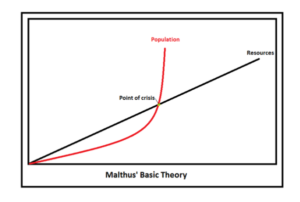
Criticism
The Malthusian Theory of Population has been widely criticized for its simplistic assumptions, overlooking technological advancements like the Green Revolution and the role of education, healthcare and economic development in reducing population growth. Its predictions of famine and resource shortages have largely failed to materialize, particularly in developed nations.
- In contrast to Malthus’s pessimistic view, the Demographic Transition Theory (DTT) offers a more optimistic and comprehensive explanation of population growth. It describes how populations shift from high birth and death rates to low rates as societies industrialize, urbanize, and improve living standards.
- DTT provides a universally applicable framework for understanding population dynamics and is crucial for modern demographic studies and policy planning.
Demographic Transition Theory (DTT)
The Demographic Transition Theory explains the transformation of countries from high birth and death rates to low birth and death rates as they develop economically and socially. It highlights how population growth evolves through four distinct stages:
Stage 1: High Stationary
- Characteristics: Both birth ratesand death rates are high.
- Population Growth: The population remains stable or grows very slowly because high birth rates are offset by high death rates.
- Causes: Poor healthcare, limited access to sanitation, high infant mortality, and absence of family planning.
- Society Type: Agrarian societies with limited technological advancement and healthcare infrastructure.
- Bad Equilibrium: A high birth rate and high death rate create a bad equilibrium where high mortality reduces life expectancy and high fertility strains resources like healthcare and food.
Stage 2: Early Expanding
- Characteristics: Death rates start to fall significantly, while birth rates remain high.
- Population Growth: Rapid population growth due to the decline in death rates, but birth rates remain high.
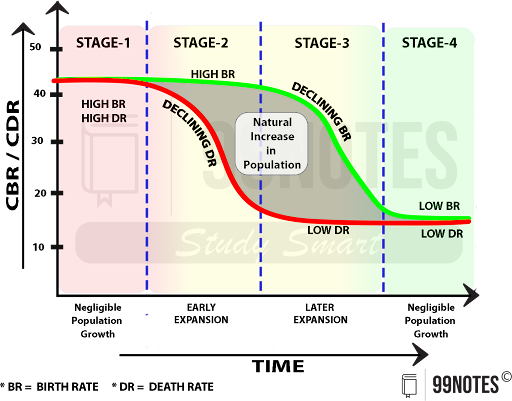
- Causes: Improvements in healthcare, sanitation, food production, and medical technologies.
- Society Type: Countries in the early stages of industrialization, developing nations with improvements in living conditions.
Stage 3: Late Expanding
- Characteristics: Both birth rates and death rates decline.
- Population Growth: Population growth slows down as birth rates decrease, though the population continues to grow due to the previous high birth rates.
- Causes: Improved education, urbanization, family planning, and increased participation of women in the workforce.
- Society Type: Industrialized and rapidly urbanizing nations, with improving standards of living.
Stage 4: Low Stationary
- Characteristics: Both birth rates and death rates are low and stable.
- Population Growth: Population growth becomes very slow or stabilizes, and in some cases, it may be negative.
- Causes: High standards of living, advanced healthcare, widespread education, gender equality, and access to family planning.
- Society Type: Fully industrialized, developed nations with high living standards and advanced technological and healthcare systems.
- Good Equilibrium: A low birth rate and low death rate create a good equilibrium with sustainable population growth, reflecting better healthcare, higher life expectancy, and efficient use of resources.
Population Pyramid
- A population pyramid is a graphical representation of the age and sex distribution of a population, providing insights into demographic trends and population structure. It visually depicts the proportion of individuals in different age groups, typically divided into male and female categories, from young children to the elderly.
- The shape of the pyramid reflects various factors such as birth rate, death rate and migration, offering a snapshot of population growth, ageing and potential future trends.
- A population pyramid is essential for understanding the socio-economic dynamics of a country, helping policymakers plan for education, healthcare, employment and social services. It serves as a tool for analysing the challenges posed by a growing or ageing population, as well as the potential for future development.
Types of Population Pyramids
Population pyramids are categorized based on their shape, which reflects the demographic stage of the population.
1. Expanding Population Pyramid
- Shape: A broad base with a narrow top, indicating a young and rapidly growing population.

- Characteristics:
- High birth rate: A significant number of births per year, typical of developing countries where families tend to have more children due to social, cultural, or economic reasons.
- High death rate: Death rates are initially high, but improvements in healthcare, sanitation, and nutrition lead to a decline over time. Despite the improvements, mortality remains higher in earlier stages of development.
- Predominantly young population: The majority of the population falls into the younger age cohorts (0-14 years), which results in a large youth population.
- Example: Developing countries such as Nigeria and Ethiopia often exhibit an expansive pyramid.
2. Stationary Population Pyramid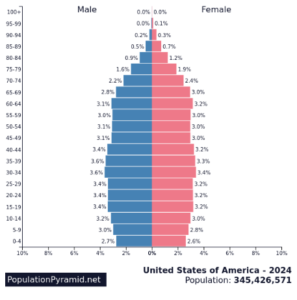
- Shape: A narrow base and top, with nearly equal bars in the middle, representing a balanced age structure.
- Characteristics:
- Stable population: Birth and death rates are low and balanced, meaning the population size remains relatively constant. This can indicate a country that has reached replacement-level fertility (the fertility rate at which a population exactly replaces itself from one generation to the next).
- Low birth and death rates: Both birth rates and death rates are low, reflecting improved healthcare, family planning, and overall socioeconomic development.
- Example: Developed countries such as the USA, Canada, Australia, and most European countries (e.g., France, UK) exhibit this type of population structure.
3. Contracting Population Pyramid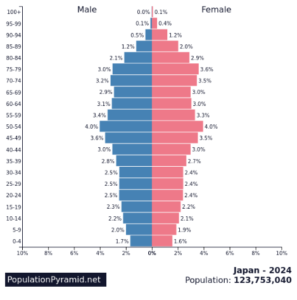
- Shape: A narrow base with a broader middle, showing a population where fewer children are born, and the proportion of elderly people is larger.
- Characteristics:
- Low birth rate: The birth rate is low, which could be due to various factors such as economic development, urbanization, family planning, and shifting cultural norms.
- Ageing population: There is a larger proportion of elderly individuals (65+ years) in the population, reflecting increasing life expectancy and lower fertility rates.
- Example: Japan, Germany, and Italy are key examples of countries exhibiting a contracting pyramid due to their low birth rates and ageing populations.
Analysis of Population Pyramid
- Age Structure: The distribution of different age groups reveals if the population is young, mature or ageing. A broad base indicates a younger population, while a narrow base suggests declining birth rates.
- Sex Ratio: The balance between males and females in each age group. Imbalances may reflect gender-specific migration, war or social preferences.
- Birth Rate: A wide base signifies a high birth rate, while a narrow base indicates lower fertility and birth rates.
- Mortality Rate and Life Expectancy: the shape of the top reflects mortality rates. A gradual taper indicates higher life expectancy; a steep taper shows higher death rates.
- Dependency ratio: The ratio of dependents (young and old) to the working-age population. A larger youth cohort suggests future workforce potential, while an ageing population indicates economic strain.
- Historical or Social Impacts: Bulges or gaps in certain age groups can indicate past events like wars, pandemics, baby boomers or significant migration patterns.
- Migration Patterns: Sharp changes in the pyramid, often among working-age adults, can indicate migration trends. A higher proportion of males or females in certain age groups may reflect labour migration or refugee movement.
- Population Growth Trends: A broad base compared to the top shows rapid population growth, while a narrow base relative to the middle suggests population stabilization or decline.
Related FAQs of POPULATION AND ASSOCIATED ISSUES
Great question! Population is a foundational topic because it connects to everything — economy, resources, planning, environment, and even governance. Understanding how people are spread, grow, or migrate helps shape policies. Our UPSC notes pdf breaks this down in simple, exam-ready formats for quick understanding.
As of the 2024 UN Report, India officially surpassed China to become the world’s most populous country, with over 1.42 billion people. This shift has major implications for jobs, urban development, and policy planning — all of which are well-explained in our upsc notes pdf on demographics!
Population growth impacts everything — from water availability and food supply to job markets and traffic jams. Too many people in one place can strain resources, while too few in another can slow economic growth. Want real-life examples? We’ve packed plenty into our UPSC notes pdf section.
The DTT is a classic! It explains how countries evolve from high birth and death rates to low ones as they develop. It’s key to understanding population trends in India and across the globe. Our UPSC notes pdf offers clear diagrams and stage-by-stage summaries to help you nail this in your exam.


